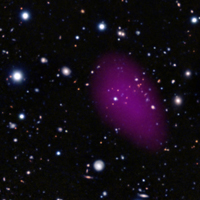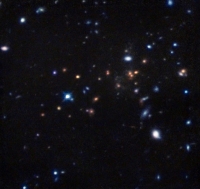An old galaxy cluster discovered in the young Universe
9 March 2011
Astronomers working with data from several observatories, including ESA's XMM-Newton, have discovered the most distant, mature galaxy cluster yet. The cluster is seen as it was when the Universe was only about a quarter of its current age. In contrast to other structures observed in the young Universe, this object is already in its prime, as is evident from its diffuse X-ray emission and evolved population of galaxies. This shows that fully-grown galaxy clusters were already in place this early in cosmic history.
 |
|
Composite near-infrared and X-ray image of the galaxy cluster CL J1449+0856, from XMM-Newton data and ground based observations. Credit: ESA/ESO/Subaru/R. Gobat et al. |
Given that galaxy clusters are scarce, and even more so at high redshifts where they are still taking shape, these observations are challenging. "This is why discovering a galaxy cluster at a redshift of 2 feels like unearthing a rare and valuable gem," says Raphael Gobat from the Commissariat à l'Énergie Atomique (CEA), in France, who led the extensive study that revealed what appears to be the most distant galaxy cluster detected yet.
CL J1449+0856, the newly-found galaxy cluster, is seen at an era when the Universe was only 3 billion years old — less than a quarter of its present age. "As well as being at a record-breaking distance, what makes this object rather unique is that it's not a proto-cluster undergoing formation, as are many that have been detected at high redshifts, but it is already mature, a proper galaxy cluster," adds Gobat.
A signature of its advanced evolutionary state is the diffuse X-ray emission associated with the cluster, observed with ESA's XMM-Newton. "Only galaxy clusters that have had time to fully develop, collapsing under the influence of their own gravity, are visible in X-rays," explains Alexis Finoguenov from the Max-Planck-Institut für extraterrestrische Physik (MPE), in Germany, co-author of the paper in which the result is presented. The X-ray emission originates from the hot intra-cluster gas: subject to the cluster's gravitational potential, the gas is compressed and heated to temperatures of over 10 million Kelvin, and shines at X-ray wavelengths.
The X-ray data not only show evidence that this is a fully-formed cluster, but also allow characterisation of its properties. The researchers estimate that the mass of the cluster is about
With masses that have not yet reached extreme values, high-redshift clusters are relatively faint X-ray sources and are thus particularly hard to observe. Furthermore, their emission peaks in the soft X-ray band. "As it is more sensitive to soft X-rays than other instruments, XMM-Newton is the ideal tool to detect the signal from mature clusters in the young Universe," remarks Norbert Schartel, ESA'S XMM-Newton Project Scientist.
 |
|
Hubble's near-infrared view of galaxy cluster CL J1449+0856 |
They also examined the characteristics of the galaxies in greater detail using data that included observations by the NASA/ESA Hubble Space Telescope, and found that most of them have quite compact shapes, consistent with what is expected for galaxies with a bulge dominated by old stars. "The fact that the stellar populations in the galaxies had time to evolve is an additional sign of the cluster's maturity, along with its X-ray signal," Daddi adds. The evidence obtained all points in the same direction, but the team's efforts are not over and they are investigating this structure in even greater detail to study how early galaxy formation and the assembly process of a galaxy cluster are affected by the environment.
A serendipitous discovery corroborated by a body of deep and high-quality data, the record set by this finding is unlikely to be broken in the near future, as theory predicts that chances of finding similar clusters at redshifts of 2 or more using state-of-the-art instruments are low — only about a few per cent. "A single detection like ours is compatible with this small probability and can still be accommodated within current cosmological models," explains Gobat. However, if deeper and larger surveys were to detect more objects like this, the most widely accepted theory for the formation of cosmic structure would require revision. "This discovery has shown, for the first time, that old clusters were already present in the young Universe and that we are able to observe them. Only time will tell us what 'old' and 'young' really mean and what this implies in the broader context of cosmology," he adds.
Notes for editors
The galaxy cluster discovered in this study, named CL J1449+0856, was originally identified in archival images from the Spitzer Space Telescope as an excess density of galaxies with emission peaking at red and infrared wavelengths. The data cover 342 square arc minutes of the 'Daddi Field'.
Further observations revealed a wealth of distant galaxies in this field, with emission that peaks at different wavelengths – galaxies with younger stellar populations peaking at bluer wavelengths, those with older stellar populations peaking at redder wavelengths. The redshifts of 109 'blue' galaxies have been measured spectroscopically and their redshift distribution peaks at z=2.07. For the 'red' galaxies, only photometric redshifts were estimated and the distribution of their redshifts peaks at z=2.05. The agreement of these two estimates indicates that the cluster redshift lies in the range z=2–2.1.
The cluster luminosity (L), measured from the X-ray data, is approximately
This multi-wavelength study is based on observations performed with a number of ground- and space-based observatories: infrared data from NASA's Spitzer Space Telescope; optical and near-infrared data from the Subaru Telescope of the National Astronomical Observatory of Japan, the Very Large Telescope of the European Southern Observatory, the William Herschel Telescope, the NASA/ESA Hubble Space Telescope and the W.M. Keck Observatory; X-ray data from ESA's XMM-Newton and NASA's Chandra X-ray observatories.
The X-ray data from both observatories exhibit detections that correspond to the cluster, however, only the XMM-Newton detection is associated with the diffuse intra-cluster gas, which is key to the findings presented in this paper, whereas the Chandra detection is associated with one of the galaxies belonging to the cluster.
Related publication
Gobat, R., et al., "A mature cluster with X-ray emission at z=2.07", A&A, 2011, 526, A133. DOI: 10.1051/0004-6361/201016084
Contacts
Raphael Gobat
CEA Saclay
Service d'Astrophysique
France
Email: raphael.gobat cea.fr
cea.fr
Phone: +33-1-69086001
Emanuele Daddi
CEA Saclay
Service d'Astrophysique
France
Email: emanuele.daddi cea.fr
cea.fr
Phone: +33-1-69086793
Alexis Finoguenov
Max Planck Institute for Extraterrestrial Physics
Garching, Germany
Email: alexis mpe.mpg.de
mpe.mpg.de
Phone: +49-89-30000-3644
Norbert Schartel
ESA XMM-Newton Project Scientist
Directorate of Science and Robotic Exploration
European Space Agency
Email: Norbert.Schartel esa.int
esa.int
Phone: +34-91-8131-184

